1991 Ski-Doo Mach 1 XTX Vintage Review

The power of Ski-Doo's 617cc twin combined with a 138-inch track
In model year 2012 we look at high-powered stretch track sleds as the hot set up for uneven snow conditions. We like the latest elongated track models like Polaris’ Switchback and Ski-Doo’s Renegade series because they give us a better ride over marginally groomed trails, allow us to venture off trail and because they are nearly as nimble and quick as the shorter tracked models from which they evolved.
If you want to talk evolution for the 2012 Ski-Doo crossovers, you might want to go beyond the MXZ REV and look back about 20 years to the 1991 Ski-Doo Formula Mach 1 XTC. As the top of the line Ski-Doo hot rod of the early 1990s, the Mach 1 came with a new to the trail Rotax twin. Measuring 617cc in displacement from a bore and stroke of 76mm x 68mm, the 1991 Mach 1 engine evolved from the successful 580 twin. In fact, the 617 came to be known euphemistically as the long stroke 580, which had been raced the previous season in Formula III events. This 617 enjoyed all the benefits of the 580 but with a longer stroke that enhanced its power by 10 percent over the base 580. On paper and doing the math, since the 580 generated a reported 100 horsepower and the 617 was 10 percent stronger, it would pump out about 110 horses at 6800 revs.
Part of the reason for the larger displacement engine was to counteract Polaris’ 650cc series, which in the early 1990s included an electronically fuel injected triple. While Polaris’ Fuji-built three cylinder had greater displacement, the Rotax 617 reportedly enjoyed a horsepower advantage.
Since the long stroke engine offered more midrange torque, the Mach 1 became more than a high performance racer wannabe model as Ski-Doo marketing gurus decided to enhance the platform and expand the model line to include a long track version. By adding a 138-inch long Kevlar reinforced rubber track underneath the Mach 1, Ski-Doo marketers felt they could gain more top-end buyers who wanted the performance and on-trail comfort of this new X-Tra Traction and Comfort (XTC) edition.
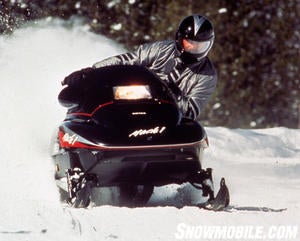 Suspension travel measured less than 6-inches front and rear in the high-performance Mach 1 series.
Suspension travel measured less than 6-inches front and rear in the high-performance Mach 1 series.
Creating the Mach 1 XTC model required more than simply adding a longer track. The XTC went with wider 5.5-inch skis for improved deep snow handling. There was also the ability to add electric start to the Mach 1 XTC, which would add versatility. With the extra length, the XTC was fitted with a modified two-up seat that blended in with the styled wraparound rear cargo rack, which doubled as passenger handgrips. Think of this two-up being more for occasional than serious long distance riding in the way a modern sport bike offers a passenger pillion. Serious two-up travelers would go for the traditional touring sled models, but it did allow the marriage partner the out of being able to take the family along. Yeah, right!
Before the 1991 Mach 1 XTC made it to Ski-Doo dealer showrooms, Bombardier conducted serious consumer research and borrowed technology from its Formula 1 twin track racing sleds. The Mach 1 reflects input from real world snowmobilers, which resulted in a new style handlebar. Consumers felt the previous sport bar was too straight, but they didn’t like the chopper-style handlebar of earlier Formula models either. Ski-Doo referred to its 1991 Mach 1 design as “more-human.” The two-inch longer handlebar gave riders more leverage with less steering effort. Ski-Doo engineers felt that the new style enabled riders to steer more with their shoulders than their forearms, allowing improvements in both handling and maneuverability.
The taller more effective standard windshield seen on the 1991 Mach 1 resulted from consumers’ desire for greater warmth. But they also desired more choice and a smaller, sport-styled version became available as well. There were available tint and clear versions.
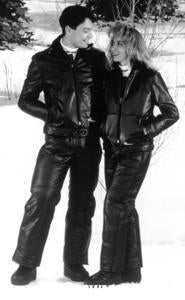 Twenty years ago performance suits were styled in black leather.
Twenty years ago performance suits were styled in black leather.
Even the Mach 1 styling resulted from consumer input. Performance riders demanded a strong sense of power and speed, which equated to the color black. The theme carried from nose to mudflap with an aggressive graphics package in red and silver.
Racing thematics showed up in the form of wind-tunnel testing to hone the aerodynamic hood and assist in placing the front duct work to cool underhood components. These naca ducts invite airflow with minimal exterior surface disruption and have been used in fighter jets and NASCAR racers for many years. The sled’s side vents not only brought in cooling air but also filtered exiting warm air back toward the rider.
But, of course, style and race-inspired design don’t matter if the sled is a slug. That’s why the top of the line Mach 1 came with the 617 twin cylinder motor. The previous season, Ski-Doo Formula III driver Wayne Nicholsen used a 617cc prototype engine to power him to seven wins and two seasonal championships. The production engine featured both rotary valve induction working with dual 40mm Mikuni carburetors and twin RAVE (Rotax Automatic Variable Exhaust) exhaust valves. The claimed result was to increase low end torque for strong acceleration and midrange performance while maintaining consistent top end speed.
Since this was the era of big carbs and heavy-thumb throttles, the Mach 1 utilized the Ski-Doo engineered progressive action throttle that allowed light pull up to about half throttle before going all in to the wide open throttle position. The system worked well in most cases and seemed well suited to the XTC models, whose riders may have been a bit less aggressive than the short track Mach 1 crowd.
Although styled with a racer theme, the suspension systems were average at best. The Progressive Reaction Suspension systems front and rear were okay for the times, but when you look at the maximum allowed travel of 5.2-inches up front and 5.8-inches at the rear, you can see that suspension designs have come a long, long way. The PRS front end had a ski stance of about three feet from its unique trailing arm design. This suspension remained one of the more consistent ski suspensions for Ski-Doo until the company went to the REV. The Polaris trailing design was more versatile and easier to upgrade.
The rear monoshock parallel rail suspension’s 5.8-inches of useable travel utilized a nitrogen pressurized Marzzochi shock. Unlike shocks used by competitors Arctic Cat and Polaris, the Mach 1 shock was not designed to be rebuilt, but Ski-Doo engineers came up with satisfactory damping for a good ride.
In its day, the 1991 Ski-Doo Formula Mach 1 XTC established itself as a solid trail performer. The 617cc Rotax twin offered strong acceleration in that critical 30 mph to 60 mph window and it could roll the long tracked sled to triple digits on a hard packed lake surface.
While most likely not a highly sought classic, this 1991 Ski-Doo extra length model showcased strong Rotax performance with classic Quebec-style high mileage touring comfort.
| 1991 Ski-Doo Formula Mach 1 XTC Specs | |
| Engine | Rotax 617cc liquid-cooled twin; rotary valve induction with 2x VM40 Mikuni; CD ignition; oil injected; tuned exhaust; optimum engine RPM @ 7650 |
| Horsepower | NA |
| Drive | Ski-Doo/Rotax Total Range Adjustable Clutch (TRAC), 3 ramps; Ski-Doo secondary |
| Front Suspension | Progressive reaction system (PRS); trailing arm design with 5.2 in travel |
| Rear Suspension | Ski-Doo PRS monoshock with 5.8-in travel |
| Length | 116.7 in |
| Width | 40.9 in |
| Height | 47.9 in |
| Ski Stance | 36.3 in |
| Track | 16.1-in x 138.0-in rubber with Kevlar reinforcement |
| Weight | 534 |
| Brake | Self-adjusting disc |
| Fuel Capacity | 10.8 US Gal |
| Features | Gauges (speedo, odometer, tach, electric fuel gauge); high windshield; parking brake; Optional: electric start, hitch kit |
| Price | US$6,549 |
Related Reading
1987 Ski-Doo Stratos Vintage Review
1974 Ski-Doo T’NT 440 Everest
Ski-Doo Creates Elite Status



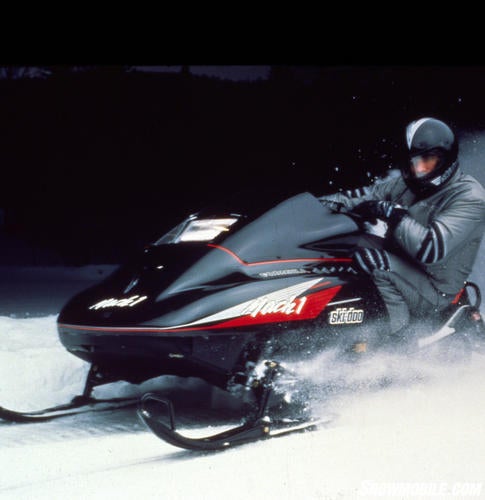
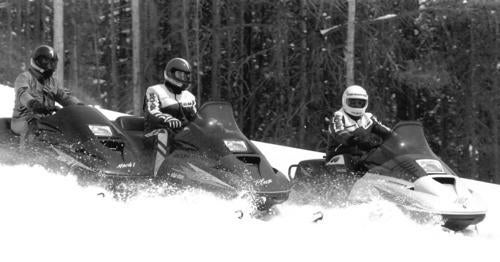
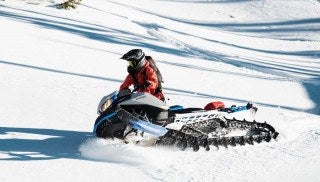




 Your Privacy Choices
Your Privacy Choices